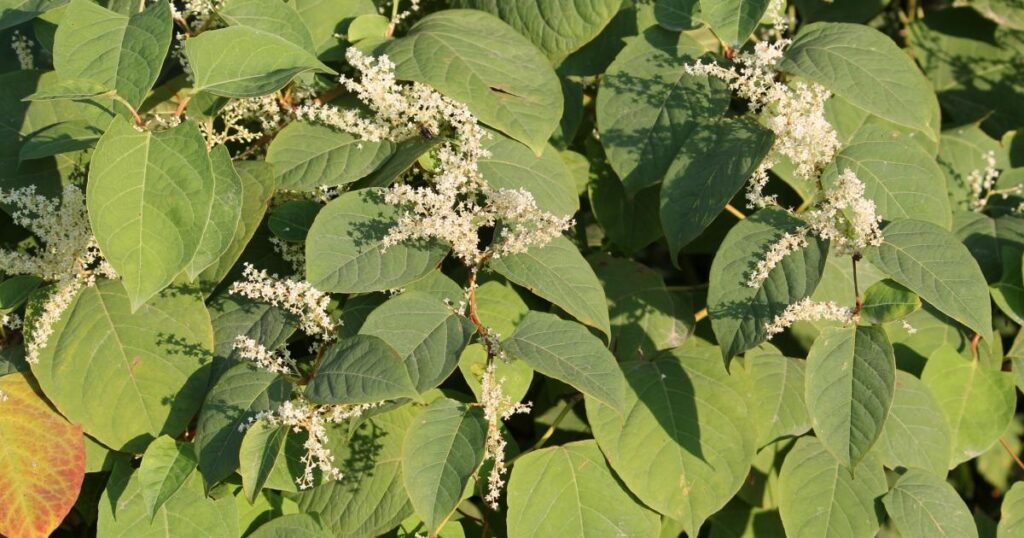Many can lead to your home losing value, so it is important to know when to look out for these plants and how to report and or remove them.
This aggressive plant grows quickly and its roots can burrow deep underground – sometimes up to 3 metres down.
Here is all to know about Japanese Knotweed, including what it looks like, when it flowers in the UK and how to report and remove it.
What does Japanese Knotweed look like and when does it flower in the UK?
The Royal Horticultural Society (RHS) describes Japanese Knotweed as “a persistent, clump-forming herbaceous perennial”.
It grows “rapidly in summer and is most prominent from August to September”, says Saga’s home insurance and property expert Anna Thunstrom.
She explained: “Keep an eye out for its characteristic shield or shovel-shaped leaves, along with clusters of creamy white flowers that bloom during late summer”.
However, the RHS warns that while Japanese knotweed stems die back in winter, in sheltered locations, dead stems may remain upright through the winter.
What to do if I find Japanese Knotweed?
While it is not an offence to have Japanese knotweed growing in your garden, it is an offence to plant or cause to grow in the wild and you should take steps to prevent it spreading.
Japanese Knotweed, now Europe’s most invasive plant, won the Gold Medal from the Utrecht Society of Agriculture and Horticulture for best ornamental plant in 1847. pic.twitter.com/OQZFU7wo4i
— Quite Interesting (@qikipedia) February 15, 2019
It can also cause damage to your property, as the expert Ms Thunstrom explains: “Japanese knotweed is particularly notorious for causing structural damage to buildings, potentially impacting the property’s value.
“As a result, sellers are obliged to disclose its presence.”
She also warns to act quick, as it could “anywhere between £1,000 to £12,000 to have Japanese Knotweed removed, depending on the garden size and severity of the infestation”.
Japanese Knotweed UK Law
As the RHS explains: “Japanese knotweed is listed on Schedule 9 of the Wildlife and Countryside Act 1981, Section 14, making it an offence to plant or cause Japanese knotweed to grow in the wild.
“The penalties for offences under Section 14 include fines and imprisonment.”
While it is not illegal to have Japanese knotweed in your garden, it is important to control it to prevent it becoming a problem in your neighbourhood.
As explained by the RHS as part of the Anti-social Behaviour, Crime and Policing Act 2014, if Japanese Knotweed has a “detrimental effect of a persistent or continuing nature on the quality of life of those in the locality”, property owners may be prosecuted.
If problems with the plant happen in a neighbouring garden, you should be in touch with your neighbour about it before contacting your local council.
Can I treat Japanese Knotweed myself? How to get rid of it
It is advised to get professionals to come and remove Japanese Knotweed.
Thomson Environmental Consultants are experts in invasive species management, and have experience in controlling and managing Japanese Knotweed.
Craig Godbehere, a site supervisor and certified surveyor in Japanese Knotweed at Thomson, explained various control measures that can be used to manage the Japanese Knotweed on a site.
These are:
- In-situ treatment using approved herbicides
- Controlled contaminated soils from the site to an approved facility using an approved waste carrier
- Burial at either 5m with a cap or 2m completely encapsulated
- Stockpiling of the contaminated soils
- Soil screening/sieving with potential re-use on-site
- ‘Installation of Root Barriers’ where all contamination can’t be removed
Mr Godbehere added: “Strict biosecurity measures should be enforced to prevent the accidental spread of the Japanese Knotweed.
“All plants, vehicles, equipment, and clothing must be thoroughly cleaned before leaving contaminated areas.
“Cleaning should take place in the location (or immediate vicinity) where the soil or living material originated before equipment and personnel leave the buffer zone.”
Recommended reading:
He also explained how herbicide treatment is regularly used, as this is usually the most cost-effective option.
However, he warned that herbicide treatment shouldn’t be used in isolation where there is likely to be future soil disturbance around the infested area.
“If this option is used, achieving the desired results may take many years,” he said.
Source link
[Featured]
[Just In]




